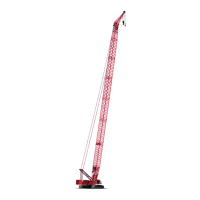Manitowoc Published 05-03-17, Control # 228-03 7-3
16000 SERVICE/MAINTENANCE MANUAL POWER TRAIN
Table 7-3 Open Circuit Cell Voltage
NOTE: The meter manufacturer will provide detailed test
information.
High Resistance Test
When cranking, a voltage drop of more than 0.2 volts
between the starting motor cable and ground can cause hard
starting. The voltage drop can be caused by a poor contact
between the cable terminal and ground or between the
clamp terminal and the battery post, or by poor start-switch
contacts and frayed, broken, or corroded cables.
Quarterly - Clean and Inspect Batteries
Perform the following checks quarterly:
1. Thoroughly clean the batteries and the holder with
baking soda.
2. If provided, make sure the drain holes are open in the
holder. If water collects in the holder, drill drain holes.
3. Clean the posts and terminals. The posts can be
completely coated with grease to prevent corrosion.
4. Make sure the hold-downs are in good condition.
Replace faulty parts. Make sure the hold-downs are tight
enough to prevent battery movement without causing
distortion.
5. Replace frayed, broken, or corroded cables.
6. Replace the batteries with containers that are cracked or
worn enough to leak.
7. Ensure a tight contact between the clamp terminals and
battery posts.
Charging
The battery should be at room temperature when recharging.
Before recharging a battery, clean it thoroughly. Do not allow
dirt to enter the cells.
Recharge a battery the way it was discharged. For batteries
discharged over a long period of time, recharge slowly at 6 to
10 amperes for up to 10 hours. (For a slow rate, use a
current equal to approximately one-half the number of plates
per cell in the battery. For instance, charge a battery with 13
plates per cell at 7 amperes.
If a battery was discharged rapidly (for instance, cranking
until dead), recharge it using a fast charger with an output of
up to 40 amperes for a maximum of 2 hours. If the electrolyte
temperature reaches 52°C (126ºF) or gases violently, reduce
the charging current or stop charging to avoid battery
damage.
For optimum charging results, follow the charger manufac-
turer’s instructions.
Storage
Run the crane periodically to charge the batteries when the
crane is left idle for prolonged periods.
When storing a battery, make sure it is at least 75% charged
to prevent the possibility of freezing.
Follow the battery dealer recommendations.
Disconnect Switch
See Figure 7-2 for the following procedure.
A battery disconnect switch is provided on the right side of
the upperworks near the engine node. Use the switch to dis-
connect the batteries when servicing the electrical control
system.
See Section 3 of the Operator Manual for operation of the
battery disconnect switch.
% Charge Specific Gravity
Approximate
Open Circuit
Cell Voltage
100 1.260 2.10
75 1.230 2.07
50 1.200 2.04
25 1.170 2.01
Discharged 1.110 1.95
CAUTION
Engine Damage!
To avoid possible engine fault codes and undesirable
operation, make sure the engine ignition switch has been
off for five minutes before disconnecting the batteries.
Do not rely on this switch to protect the crane’s electronic
systems when welding. Disconnect the battery cables at
the batteries before welding.
FIGURE 7-2
Shown In
Connected
Position
IMG7563
Right Side of Rotating Bed
To
Disconnect

